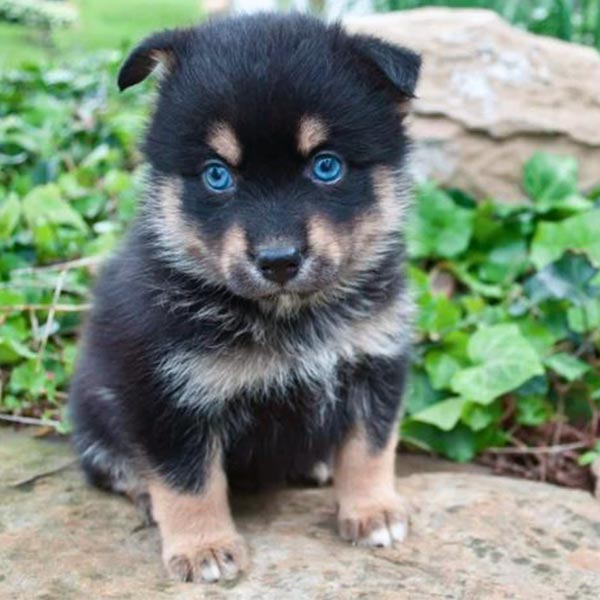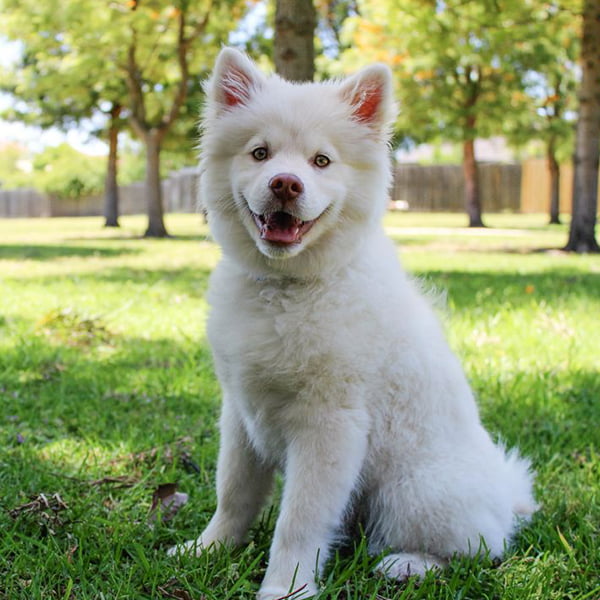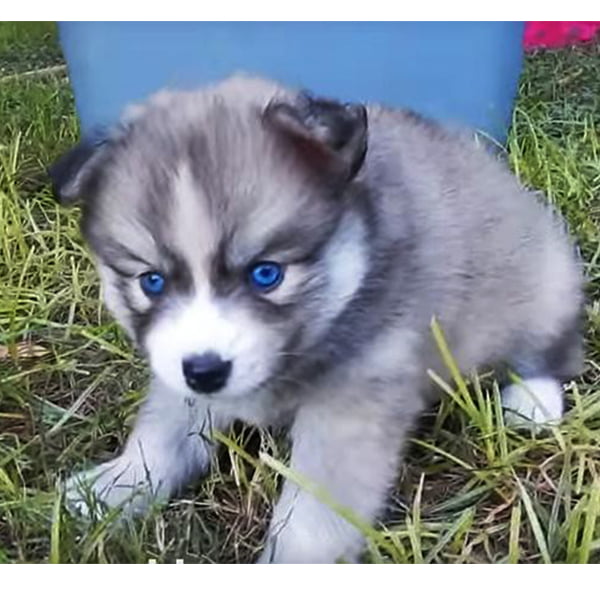The Pomeranian Husky mix breed, also known as Pomsky, has recently gained popularity among dog lovers, and it is for good reasons too!
Pomsky is a mix between Pomeranian and Siberian Husky. Siberian husky combined with Pomeranian, Pomsky have the majestic look of a Siberian Husky and the fluffy adorability of a Pomeranian. This irresistibly fluffy and cute small-size mixed breed dog is a great alternative for pet lovers who love huskies but don't have the space for a purebred husky as this breed is apartment living friendly.
Let's take a look at some of the characteristics of the cute Pomeranian Husky so you can decide if this little mischievous breed is right for you.
Parent Breeds
Pomsky is considered a designer dog breed between Pomeranian, the smallest of the spitz breeds (ex: Japanese Spitz breed), and Siberian Husky, a breed known to be the best sled dog. In the same litter, you can get a Pomsky that looks more like Siberian huskies and one that looks more like Pomeranian.
Pomsky Puppies
The first recorded litter of Pomsky puppies was born in March 2012. Therefore, most of the Pomskies you see today are the first generation of their breed. For this reason, a small amount of information is known.
Pomsky is still quite rare, and these cute puppies can be hard to find and expensive. So, how much does a Pomeranian Husky cost? A purebred Pomeranian Husky costs anywhere between $1,000 to $5,000 from a good breeder. However, Pomsky can end up in the care of animal shelters or rescues, be sure to consider adoption first.
Breed Characteristics
Temperament | Playful, outgoing, stubborn |
Intelligence | High |
Affection/Friendliness | Very affectionate with family |
Trainability | Moderate |
Mental Stimulation | High – tricks, agility, puzzle toys |
Exercise Needs | Moderate to high – walks, play, running |
Apartment Living | Suitable with exercise |
Family Friendly | Yes, best with older children |
Pet Friendly | Moderate, early socialization needed |
Drooling Level | Low |
Energy Level | Moderate to high |
Loneliness Tolerance | Low |
Adaptability | Moderate |
Tendency to bark | High |
Origin
The origin of the Pomsky dog breed is particularly unique. It began in 2011 when a BuzzFeed article suggested how cute a hybrid of a husky and a Pomeranian would be and then provided photos of what the little designer breeds might look like. This article took off, and people fell in love with the still nonexistent breed. Given the size difference between the breeds, it was unrealistic to hope that a real Pomeranian Husky could ever be bred.
However, in late 2011 or 2012, artificial insemination was beginning to be used for crossbreeding different species that would otherwise be unsafe or inhuman to breed otherwise. And so, with the help of artificial insemination, the Pomeranian Husky, or the Pomsky, finally became a reality.
This hybrid designer-breed dog is still very new and is thus not recognized by any kennel clubs, including organizations like American Kennel Club. Owners looking to buy will need to do vigorous research to find a reputable breeder to ensure that humane and safe breeding has been practiced and that the little puppies come from healthy and purebred dog parents.
Avoid puppy mill operations and backyard breeders, as they can come with innumerable health issues, and you may not get what you think you paid for. Not to mention, the natural breeding of this breed is not an option for a variety of reasons. Be sure to consider adoption and rescue first.

Breed Overview
Height: 10–15"
Weight: 20-30 lbs
Height: 10-15"
Weight: 20-30 lbs
Breed Group
Designer
Life Span
12-15 years
Coat
Double coat
Coat Length
Medium
Hypoallergenic
No
Shedding Level
Moderate to high
Size
The Pomeranian Husky's size varies, as the two breeds of parents are very different in size. Pomsky is typically a small to a medium-sized dog that grows to be between 10 and 18 inches and weighs about 20 to 30 pounds.
Personality
Pomeranian Huskies are very playful dogs and have mischievous personality traits. They are loyal to their family and outgoing and friendly when properly trained and socialized. They are very smart dogs and can be a bit willful, but they love to make their owner happy.
Husky can be chatty, howling and whining, and Pomeranian can be yappy. This combination makes Pomsky a very vocal dog. For people who are sensitive to noise or have a low tolerance for noise, Pomsky may not be a good fit.

Appearance/Colors
Pomeranian Huskies get a wide color and pattern palette from both Husky and Pomeranian parents. They can come in brown, chocolate, liver, red, gray, blue, and white coat colors. Bicolored, tricolored, brindle, flecked, ticked, speckled, and tuxedos are possible patterns.
Their coat consists of a medium-length double coat that makes them appear like fluffier huskies. Their eyes can be anything from hazel to sky blue, and some Pomsky puppies will even have two different eye colors.
Temperament
Pomeranian Huskies can make good family dogs due to their playfulness and energy. However, their smaller size may make them wary of very small children. They can also be hyper-vigilant around strangers due to their loyalty to their families. If they are trained and socialized early, you can counter much of this, and they will be well-behaved and fun dogs. These designer dogs can get along well with other dogs, though they may chase smaller pets, including cats, around due to their prey drive.
Diet/Nutritional Needs
Pomeranian Huskies have dietary needs like any other dog. They need fresh water at all times and quality canine food that is appropriate for their age, size, and activity levels. You can consult with your vet about the best time to transition your Pomsky puppy to adult food and for advice on quantity.
You should avoid giving your dog too many treats or scars of human food since this can lead to obesity and many health issues. Dental chews can also be offered regularly to help maintain dental health.
If you are unsure about your dog's diet, be sure to consult with your veterinarian.

Activity/Exercise Needs
Pomeranian Huskies are very active dogs with a pretty high drive, thanks to their Husky parents. These dogs will require rigorous daily activities to maintain optimum physical and mental health. These dogs love walks, running, hiking, fetch, playing in a dog park, and other traditional outdoor activities, but they also enjoy swimming and snow sports.
To keep your Pomeranian Husky mentally challenged, you should get puzzle toys or a food puzzle feeder bowl. Without regular activity and mental engagement, your Pomeranian Husky will likely develop destructive behaviors such as chewing, barking, whining, and urinating indoors.
Grooming Needs
One of the primary downsides of owning a Pomeranian Husky is that this dog breed is a heavy shedder. Its double coat sheds year-round but can get even worse in the summer. This breed will require daily brushing to keep as much of the shedding at bay as possible.
Pomeranian Huskies will require regular and routine trips to the groomers to trim their hair. This should be once a month during the summer and once every three months in the less shedding seasons.
It would be best if you tried to trim your dog's nails once a month and regularly examine your dog's ears for any inflammation. Veterinarians recommend daily teeth brushing, and you can give dog dental chews to help maintain dental health.
Adaptability
Pomeranian Huskies are a pretty adaptable and flexible dog breed. They can be taught to get along with children, other dogs, and possibly other small pets with proper obedience training.
Pomskies are good apartment dogs, provided they get plenty of exercise every day. Otherwise, their barking could become annoying to any neighbors. This breed does tend to suffer from separation anxiety as well, so don't get this dog if you won't be able to incorporate it into daily life. This dog breed is very cold weather tolerant and does fine in the heat so long as it has water and shade.
Trainability
Pomskies are highly intelligent dogs and must be trained and socialized rigorously and early if they are going to be polite and well-mannered adult dogs. They can be challenging to train as their stubbornness can sometimes translate into "small dog syndrome." However, you can train this learned behavior.
Pomskies tend to be mischievous, willful, and even cunning, so you must be consistent and use positive reinforcement to maintain your bond with your dog while still training it to obey you.
Training and socialization should begin with this Pomeranian mix as soon as possible and should be maintained throughout your dog's life.

Life Expectancy
A healthy, well-bred Pomeranian Husky has a life expectancy of 12-15 years.
Potential Health Issues
It is still relatively early in the breed's history to predict what the Pomeranian Husky's health issues will be. They are relatively healthy designer dogs and come from relatively healthy breeds, but a few health concerns come with the individual parent breeds.
A Pomeranian Dogs Health Issues
Dental Problems
This can include too many teeth, resulting in overcrowding and increased plaque and tartar buildup.
Ear Issues
Common ear issues include infection, wax buildup, blockage, and overgrown hair.
Skin Conditions
Skin conditions like dermatitis can be common among Pomsky. Other conditions can vary from parasite infestation, mange, ringworm, bacterial or fungal infections, and allergies.
Siberian Husky Health Issues
Eye Conditions and Sensitivities
The most common eye problems associated with the Husky breed are juvenile cataracts, corneal dystrophy, and progressive retinal atrophy.
Hip Dysplasia
Hip dysplasia is a common issue in many mediums to large dog breeds leading to the malformation of their hip joints, even as early as their puppy days.
